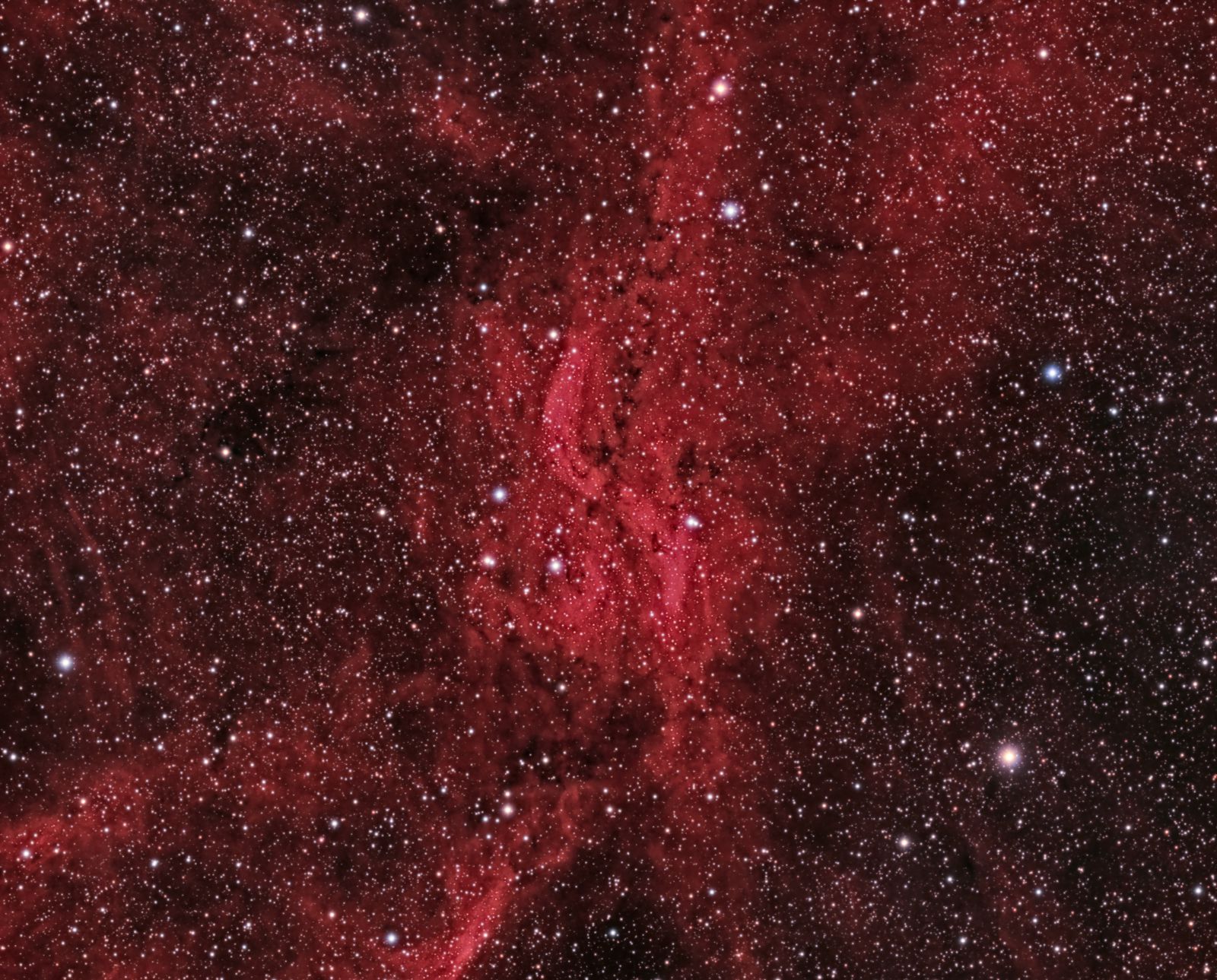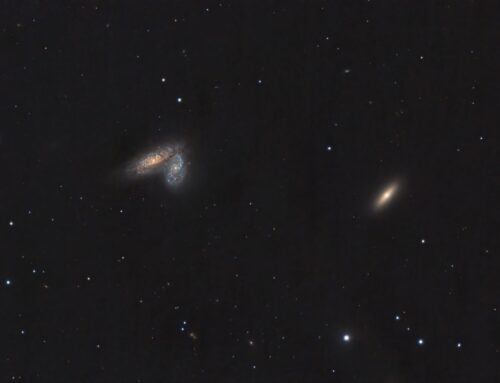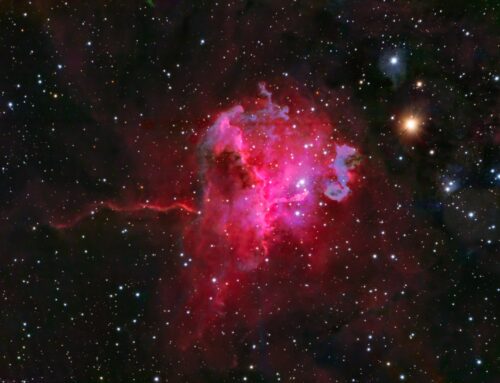Propeller Nebula

Click image for full size version
September 14, 2018
 The Propeller Nebula, centred in this image, includes DWB-111 and DWB-119. It is part of a much larger expanse of glowing hydrogen about 4,500-6,000 light years away, some of which is shown in my wide field image of this region. This is in an extremely rich part of the Milky Way, which is why it is chock-full of stars.
The Propeller Nebula, centred in this image, includes DWB-111 and DWB-119. It is part of a much larger expanse of glowing hydrogen about 4,500-6,000 light years away, some of which is shown in my wide field image of this region. This is in an extremely rich part of the Milky Way, which is why it is chock-full of stars.
For those looking for some lesser known targets, the DWB catalog was developed by H. R. Dickel, H. Wendker and J. H. Bieritz. It contains 193 H-alpha objects all in the large Cygnus-X star forming region.
Tekkies:
Sky-Watcher Esprit 150 f/7 refractor, QHY 16200-A camera, Optolong Ha, L, R, G and B filters, Paramount MX. Acquisition with TheSkyX unguided. Focused with TheSkyX @Focus3. Automation with CCDCommander. All pre-processing and processing in PixInsight. Acquired from my SkyShed in Guelph. No Moon for L, moderate moonlight for Ha and RGB, average to excellent transparency and fair to average seeing. Data acquired August 22 – September 7, 2018.
27x10m L, 12x10m R, G and B, and 46x10m Ha (Total = 25hr50m).
Data Reduction and Cleanup
The BatchPreProcessing script was used to perform calibration, cosmetic correction and registration of all frames. ImageIntegration was used to make the L, Ha, R, G and B masters. DynamicCrop was used to crop all the masters identically. DynamicBackgroundExtraction was applied to each master.
RGB:
Creation and cleanup: The R, G and B were combined to make an RGB image which was processed with PhotometricColorCalibration.
Linear Noise Reduction: MultiscaleLinearTransform was used to reduce noise in the RGB image. Layer settings for threshold and strength: Layer 1: 3.0 0.8 Layer 2: 2.5, 0.7 Layer 3: 2., 0.6 Layer 4: 1.0, 0.2 Layer 5: 0.5, 0.1.
Stretching: HistogramTransformation was applied to make a pleasing, bright image. Curve was applied to boost contrast and saturation.
Luminance:
Creation and cleanup of SynthL: The L, R, G and B masters were combined using ImageIntegration (average, additive with scaling, noise evaluation, iterative K-sigma / biweight midvariance, no pixel rejection).
Deconvolution: A star mask was made to use as a Local Deringing Support image. A copy of the image was stretched to use as a range mask. Deconvolution was applied (50 iterations, regularized Richardson-Lucy, external PSF made using DynamicPSF tool with about 30 stars).
Linear Noise Reduction: MultiscaleLinearTransform was used to reduce noise in the background areas. Layer settings for threshold and strength: Layer 1: 3.0 0.9 Layer 2: 2.0, 0.75 Layer 3: 1.0, 0.6 Layer 4: 0.5, 0.2.
Stretching: HistogramTransformation was applied to make a pleasing, bright image.
Noise Reduction and Re-Stretch: TGVDenoise was applied in L*a*b* mode with 1,000 iterations (convergence at 0.004) with a range mask applied to protect high signal areas. This was followed by a HistogramTransformation to raise the black point (but with no clipping).
H-alpha:
Deconvolution: A star mask was made to use as a Local Deringing Support image. A copy of the image was stretched to use as a range mask. Deconvolution was applied (80 iterations, regularized Richardson-Lucy, external PSF made using DynamicPSF tool with about 20 stars).
Linear Noise Reduction: MultiscaleLinearTransform was used to reduce noise in the background areas of the Ha image. Layer settings for threshold and strength: Layer 1: 3.0 0.9 Layer 2: 2.0, 0.75 Layer 3: 1.0, 0.6 Layer 4: 0.5, 0.2.
Stretching: HistogramTransformation was applied to the Ha to make a pleasing, bright image.
Combining SynthL, RGB and Ha:
SynthLRGB: The SynthL was applied to the RGB image using LRGBCombine.
SynthLHaRGB: The NBRGB script was used in nonlinear mode to add the Ha to the SynthLRGB. A multiplier of 1.2 was selected for the narrowband contribution.
Additional Processing
Nonlinear Noise Reduction: TGVDenoise was used in L*a*b* mode to reduce noise in the background areas.
Sharpening: Using a mask to protect stars, background and dim nebulosity, MultiscaleLinearTransform was used to sharpen Layers 2 and 3 (strengths of 0.1 and 0.2 respectively.
Contrast Enhancement: LocalHistogramEqualization was applied with a scale of 46 (max contrast 1.5, strength 0.3, 3 iterations). ExponentialTransformation was applied to brighten dim nebulosity (Power of Inverted Pixels, strength 0.35, no smoothing, highlights protected). MultiscaleLinearTransform was applied to sharpen layers 2 and 3 (bias of 0.2 and 0.15, respectively).
Final Steps: Background, nebula and star brightness, contrast and saturation were adjusted in several iterations using Curves with masks as required. The DarkStructureEnhance script was applied with 8 layers and a strength of 0.2. Star sizes were reduced using MorphologicalTransformation’s Morphological Selection tool with a blurred star mask that selected large and medium sized stars (selection 0.15, strength 0.4, 3 iterations).
Image scale is about 1.15 arcsec per pixel for this camera/telescope combination.






Great image Ron! Usually you use a synthetic L but on this image you shot an actual luminance layer. Would you mind explaining your thought process as to how you decide which way to go. After talking with you at the Buffalo workshop you convinced me to use a synthetic L which has worked out quite well for me and saved me some time acquiring data.
Thanks Mark. I have updated the processing description. I initially omitted to describe that I made a SynthL from the L, R, G and B masters. Sort of a “best of both worlds” or compromise approach. I am now using a camera with a 7-position filter wheel, so can shoot luminance on very clear dark nights. I then throw that in the pot with the RGB masters. I compare the SynthL to the L alone, in terms of SNR and noise, and then use the better of the two. Usually, that is the SynthL. With my previous camera, with a 5-position wheel, I used RGBHaO3 and no luminance filter.